Raspberry Pi-like RK3328 and Snapdragon 410 SBCs lead Novasom SBC onslaught
Feb 7, 2019 — by Eric Brown 2,500 views [Updated: Feb. 8] — Novasom has launched two Linux-powered, RPi-like SBCs — the Rockchip RK3328 based SBC-M7FT and Snapdragon 410E driven SBC-M8FT — plus an ESP32-based SBC-U1 board. Upcoming boards include Intel Apollo Lake and RK3399 models.
[Updated: Feb. 8] — Novasom has launched two Linux-powered, RPi-like SBCs — the Rockchip RK3328 based SBC-M7FT and Snapdragon 410E driven SBC-M8FT — plus an ESP32-based SBC-U1 board. Upcoming boards include Intel Apollo Lake and RK3399 models.
Novasom Industries has a wide range of industrial Linux-powered SBCs, most of which were launched in 2018. Over the last month, Novasom has launched two new tuxified SBCs — the SBC-M7FT and SBC-M8FT — as well as an SBC-U1 board that runs FreeRTOS on an ESP32 SoC. The company has a US office and its products are distributed by Arrow, Texim, and others.
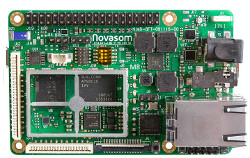
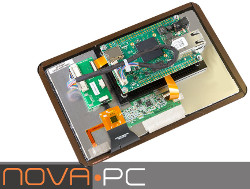
SBC-M8FT (left) and a NovaPC system
(click images to enlarge)
The Rockchip RK3328 based SBC-M7FT and Snapdragon 410C based SBC-M8FT are higher-end versions of other recently launched M-line boards. The Raspberry Pi sized M-line SBCs are intended as more robust, industrial-focused replacements for customers who tried the Raspberry Pi and found it wanting. These so-called “RASPMOOD” boards include a software layer that lets customers use the same Debian based software that run on a Raspberry Pi. RASPMOOD also refers to standardized, Raspberry Pi 85 x 56mm footprint, 40-pin expansion, and connector types and positions.
In the second quarter, Novasom will release an Intel Apollo Lake based SBC-M11 Mini-ITX board, which it has already documented (see farther below). Later in the year the company plans to release its first Rockchip RK3399 SBC with RASPMOOD support. Keep in mind that like most of the embedded products we cover on LinuxGizmos — but increasingly a minority of SBCs — these are all proprietary boards. They also have proprietary Linux kernels and stacks that “that guarantee speed, stability and functionality while charging all the system in RAM and avoiding the famous microSD ‘eating’ problems of the Raspberry Pi 3,” claimed a Novasom rep in an email to LinuxGizmos. He also touted Novasom’s free tech support and customization services.
— ADVERTISEMENT —
The M-line , U-line, and most of Novasom’s other SBCs can be configured as “NovaPCs,” which means you can purchase them with a variety of add-ons, including 5-, 7-, and 10.1-inch or larger resistive and capacitive touchscreens in “coverglass” and open frame versions. NovaPCs can also be purchased with a variety of cables and adapters.
We ran out of room to cover Novasom’s Linux-ready, NXP LS-1012 N-line and i.MX6 powered P-line and S-line SBCs. These are briefly summarized at the end of the story.
SBC-M7FT and other SBC-M7 SBCs (RK3328)
The SBC-M7FT is the most feature rich of five recently launched SBC-M7 SBCs. All the SBC-M7 boards have an RPi-like footprint and a 1.5GHz, quad-core, Cortex-A53 Rockchip RK3328 with a Mali-450 MP4 GPU. The SoC also powers the Rock64, Tinker Board S, and Firefly-RK3328, among other Linux hacker boards.


SBC-M7FT (left) and SBCM7 comparison chart
(click images to enlarge)
Like the SBC-M7D, the most recent SBC-M7FT ships with 2GB RAM instead of 1GB. The FT model is the only one with eMMC (16GB), which appears to be its only unique feature. All the SBC-M7 models provide a microSD slot and 4K-ready HDMI port with capacitive touch support. You also get a parallel camera interface and an audio output.
Other common features among the SBC-M7 boards include a USB 3.0 host port and micro-USB debug port plus an internal USB 2.0 interface “on strip.” This refers to the RPi-like, 40-pin, 1.8V GPIO connector, which offers 22 usable pins. Other “on strip” I/O includes an SPI interface and 2x I2C.
The SBC-M7 boards provide 10/100 Ethernet, which is an odd choice if you hope to outshine the Raspberry Pi. Even the RPi 3B+ has Gigabit Ethernet, although it tops out at 300Mbps, and all the RK3328 boards we’ve covered offer full GbE. However, all but the lowest-end SBC-M7A model offer “certified” WiFi/BT modules (802.11n) with an antenna connector.
The SBC-M7FT and two other models supply wide-range 6.5-18VDC power inputs, and all five are said to run at 2.5W. Other common features include a battery-backed RTC, an LED, a reset button, and a 0 to 70⁰C range. Debian Linux and Android 7.1/8.1 are supported.
SBC-M8FT and earlier SBC-M8A (Snapdragon 410)
Like the SBC-M7 SBCs, the SBC-M8 boards have an 85 x 56mm footprint, 40-pin GPIO, and other RASPMOOD features. The new SBC-M8FT and earlier SBC-M8A run Android 5.1/6, Debian 8.0/Ubuntu 14, or Windows 10 IoT Core on Qualcomm’s embedded-oriented Snapdragon 410E version of the 410 SoC, thereby providing a 10-year supply commitment. The SoC typically clocks to 1.2GHz and is accompanied by an Adreno 306 GPU, but Novasom lists it here with a more powerful Adreno 405.

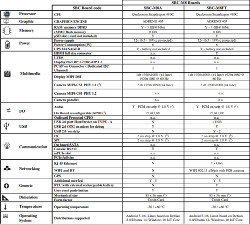
SBC-M8FT (left) and SBCM8 comparison chart
(click images to enlarge)
The new SBC-M8FT differs from the SBC-M8A with its addition of an HDMI port (resolution unstated). It also adds a GbE port plus WiFi-n with Bluetooth and an antenna connector.
Since there’s no mini-PCIe expansion on either board, the SBC-M8A presumably requires a USB-based WiFi or Ethernet add-on or a LAN signal via GPIO to connect to the Internet. It’s limited to a single micro-USB OTG port whereas the new SBC-M8FT also provides a USB 2.0 host port and a USB interface on the GPIO connector.
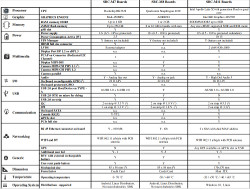
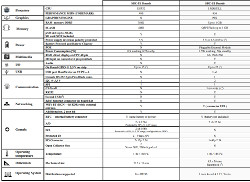
M-line (left) and U-line comparison charts
(click images to enlarge)
Otherwise, the two SBC-M8 boards are the same, with 1GB DDR3, a microSD slot, dual HD-ready MIPI-DSI interfaces, and 2-lane MIPI-CSI. Audio, SPI, and 2x I2C are found on the GPIO connector, which offers 22 usable pins, and there’s a serial console interface, LED, RTC with battery, and reset button. The board has a wide -30 to 60⁰C range and a wide 6.5-18V DC input.
SBC-M11 (Apollo Lake)
In the second quarter, the M-line will expand into x86 territory with an SBC-M11 Mini-ITX board built around an Intel Apollo Lake Atom x5-E3930 (dual-core) or Atom x5-E3940 (quad-core). The SBC-M11 will ship with up to 8GB RAM and offer eMMC, microSD, and SATA storage.
Media features include HDMI, DP, LVDS, and MIPI-DSI and -CSI. You also get 2x GbE, WiFi/BT, 3x USB 3.0, 2x USB 2.0, mini-PCIe, and 4-lane, full-size PCIe among other features. The Linux- and Windows-ready board offers extended and industrial temperature support. (See chart above for more specs.)
SBC-U5A and SBC-U5C (i.MX6 ULL)
Novasom’s U-line includes three low-power boards: SBC-U5A and higher-end SBC-U5C models that run Yocto Project Linux on NXP’s single-core, Cortex-A7 i.MX6 ULL and a brand-new SBC-U1A module that runs FreeRTOS on an ESP32 chip.
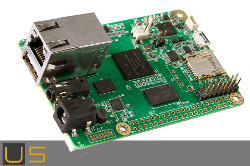
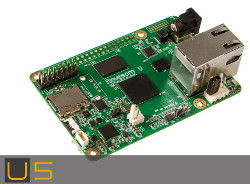
SBC-U5 from two angles
(click images to enlarge)
The SBC-U5A and SBC-U5C are both RASPMOOD models with RPi footprints and 40-pin GPIO (25 usable). They run the usual Yocto Project Linux stack (Linux 4.1.15) on the power-sipping, 900MHz i.MX6 ULL.
The SBC-U5C stands out with its certified WiFi radio with external antenna, wide-range 6.5-18V input (vs. 5V), and battery charger. Otherwise, the boards seem to be the same, providing 512MB RAM, a 3.5mm audio jack, a USB 2.0 host port, and a 10/100 Ethernet port.
A second LAN connection plus CAN and RGB with touchscreen and backlight support are available via the GPIO strip. The SBC-U5 boards provide an RTC and a -20 to 70⁰C operating range. The SBCs ship with “immediate bootstrap” and a NovaEmbed GUI app described by the Novasom rep as “a virtual machine ready for programming in a visual way all the kernel files system and boot of the board.”
SBC-U1A (ESP32)
The SBC-U1A runs FreeRTOS on Espressif’s open source, 240MHz ESP32 MCU. The sensor- and field connectivity oriented SBC-U1A is called an SBC, but we’d refer to it as a module. It has a microSD slot and WiFi/BT 4.0, but there’s no USB or other real-world ports. Then again, there’s no room for them given the 37.5 x 31mm footprint.


SBC-U1A from both sides
(click images to enlarge)
The 5V SBC-U1A ships with 384KB DDR3 and 4MB flash and supports -40 to 85⁰C temperatures. I/O includes SPI, I2C, A/D, D/A, and up to 15x GPIO. An RTC is onboard. Other details for all three U-line boards may be found in the chart farther above.
N-line, P-line, and S-line SBCs (LS102 and i.MX6)
Novasom’s N-Line is currently limited to a single N1C networking board with an NXP QorIQ Layerscape LS1012. This unique SoC has a single, 800MHz Cortex-A53 core. N1C features include 2x GbE, 3x USB 3.0, and 3x mini-PCIe.
The P-line includes three RPi-sized models with NXP’s i.MX6: the P6B (Solo), P7D (DualLite), and P8E (Quad). The latter includes SATA, CAN, and RS485, among other I/O. The S-line also showcases the i.MX6, but with a larger form factor. It includes two DualLite models — the S7B and more advanced S7C — and a more feature-rich S8FT model based on the Quad.
Further information
All the Novasom boards covered above are available now, with pricing undisclosed, except for the M11, which is due in the second quarter. More information may be found on Novasom’s Arm SBC page. The marketing-heavy website is kind of confusing, so you may have trouble finding the M-line and U-line datasheet PDFs.
At Embedded World (Feb. 26-28 in Nuremberg), Novasom will be showing the SBC-M7 boards at the Texim Europe booth (1-450) and the SBC-M8 boards at the Arrow booth.

Correction: RK3328 is a quad CA53 (armv8); RK3288 was the popular CA17-based SoC (armv7).
Would be nice if they released a laptop version of the RK3399 solution like Pine64 is doing with the Pinebook Pro (can’t wait that to arrive).